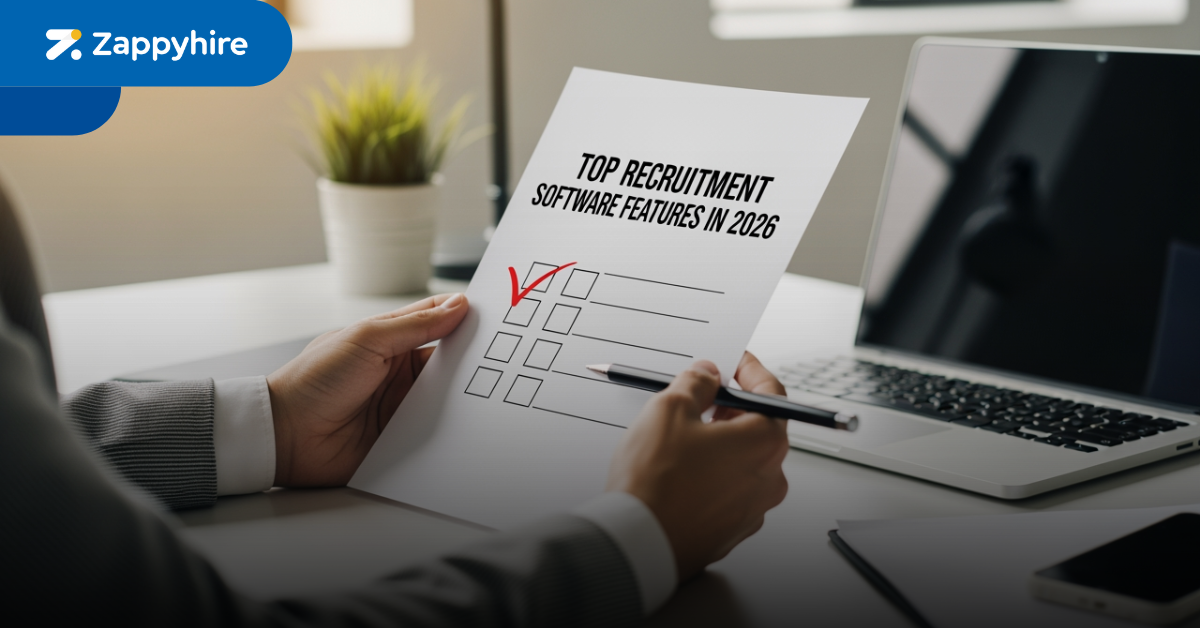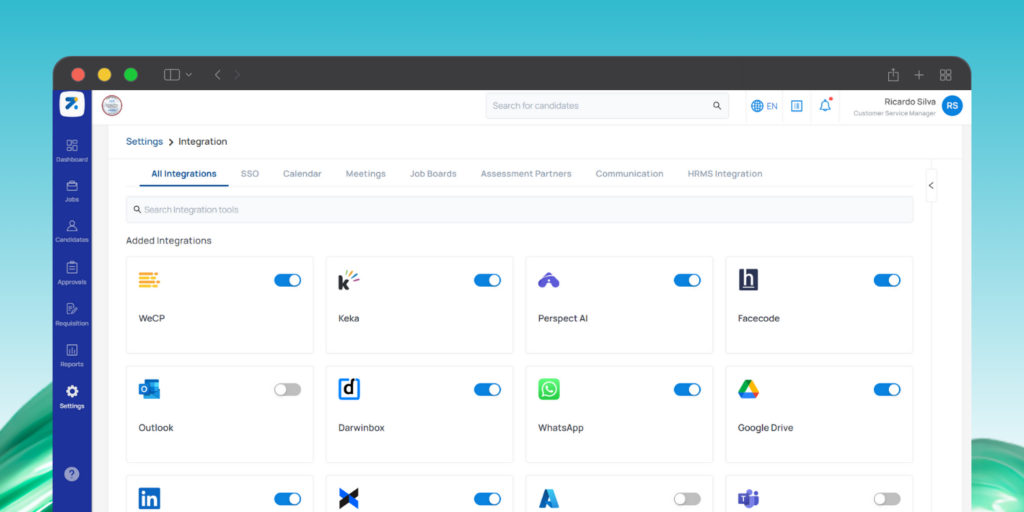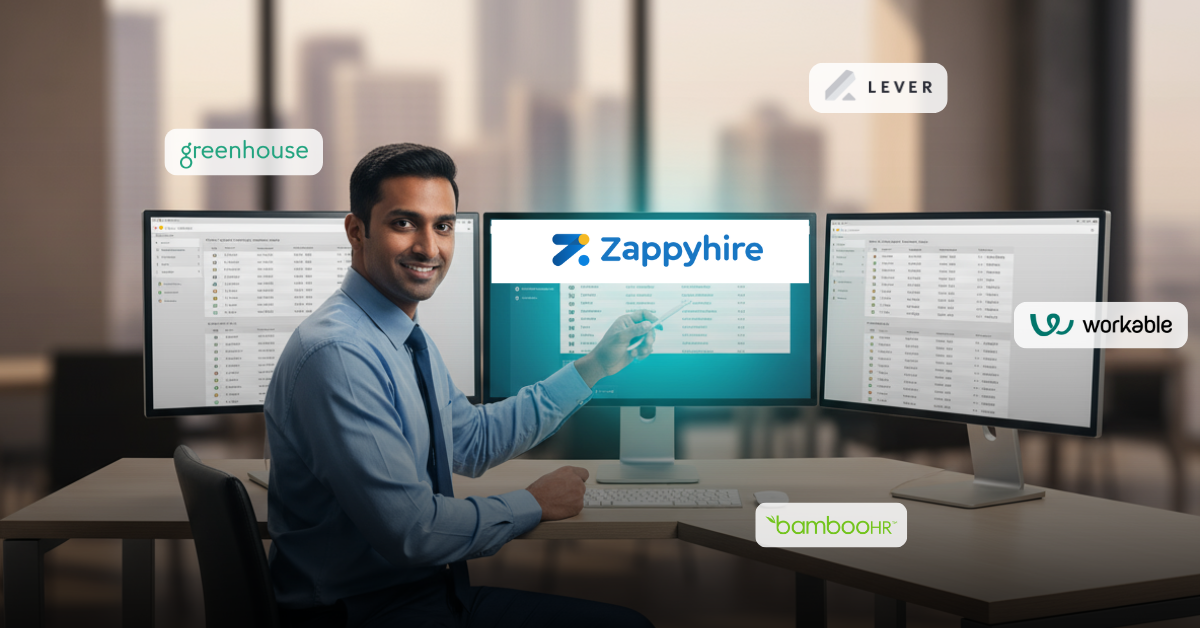
In 2025, the global recruitment software market is valued at USD 3 billion and is expected to grow at 8.5% CAGR to USD 6.2 billion by 2034. This rapid expansion reflects how organizations are racing to streamline hiring, cut costs, and eliminate inefficiencies through automation and AI.
Today’s recruitment software doesn’t just manage applications-it powers the entire hiring lifecycle, from sourcing to offers, automating tasks like posting, tracking, scheduling, and screening.
With 87% of companies already using AI in recruitment, the question is no longer whether you use technology, but whether your platform delivers efficiency, fairness, and an exceptional candidate experience.
The following guide explores the recruitment software features that will matter most in 2026. Whether you are upgrading an existing system or evaluating a new recruitment automation platform, these features will help you hire faster, smarter and more fairly.
Core recruitment features (at a glance)
Here are the foundational capabilities you should expect from any recruitment software in 2026. These are the “must‑have” features before considering advanced AI and analytics.
| Feature | What it does |
| Applicant Tracking System (ATS) | Centralises candidate records and tracks them through every stage of the hiring process. |
| Job posting & multi‑channel distribution | Publishes openings across multiple job boards (LinkedIn, Naukri, Indeed, etc.) with one click. |
| Resume parsing | Extracts candidate data (skills, experience, contact info) into structured fields for easier comparison. |
| Candidate search & filtering | Performs advanced keyword/Boolean searches to find relevant profiles quickly. |
| Pipeline management | Visualizes the candidate journey and lets recruiters move applicants between stages (Applied → Interview → Offer → Hired). |
| AI resume screening | Automatically ranks candidates against job criteria and flags high‑potential fits. |
| Chatbots / virtual assistants | Provide instant candidate engagement, answer FAQs and schedule interviews. |
| Predictive analytics | Forecasts hiring timelines, candidate success and potential attrition risks. |
| Email & SMS integration | Enables recruiters to communicate directly with candidates from within the platform. |
| Interview scheduling | Syncs with calendars (Google, Outlook) for automatic interview setup. |
| Team collaboration tools | Offer comment threads, @mentions and shared candidate notes so everyone stays aligned. |
| Generative AI tools | Drafts job descriptions, personalize outreach and summarise interviews |
| Video interviewing | Supports live and asynchronous interviews inside the platform. |
| Hiring metrics dashboards/reports | Track time‑to‑hire, cost‑per‑hire, source effectiveness and recruiter productivity. |
| Job board & social media integrations | Connect with Naukri, LinkedIn, Indeed, Facebook and more. |
| HRMS / payroll integration | Seamlessly hand over new hires to onboarding and payroll systems. |
| CRM / talent pool integration | Manage relationships with passive candidates and nurture talent communities. |
| Branded career pages | Create a company‑branded career site with job listings and employer branding. |
| Mobile‑friendly applications | Ensure candidates can apply easily via smartphones. |
| Feedback & engagement surveys | Collect candidate experience insights post‑interview to improve processes. |
| GDPR / data privacy compliance | Provide lawful storage and use of candidate data. |
| Secure document management | Store resumes, IDs and offer letters safely. |
The Most Useful Recruitment Software Features in 2026 for Large Businesses
1. AI‑powered candidate sourcing
AI-powered sourcing is the most common area where AI is applied, as they handle the bulk of work in the early stages of the recruitment process.
In fact, 97% of c-level hiring managers say they are using AI as a part of the hiring process at their company specifically for screening resumes or pre-screening interviews.
Hiring managers also reported using AI to schedule interviews (86%), assist with talent‑strategy planning (73%), write job ads (72%), conduct skills assessments (71%), complete new‑hire paperwork (69%) and check references (69%).
These tasks mirror the early‑stage workloads AI‑powered sourcing tools can automate. These tools help teams handle high volume hiring by,
- Programmatic sourcing – AI crawls job boards, social networks and talent communities to identify potential candidates based on skills, experience and behavior..
- Resume parsing and ranking – Machine‑learning models extract information from resumes and compare it against job requirements.
- Bias mitigation – Properly trained AI can help reduce unconscious bias by anonymizing resumes and standardizing evaluations.
- Talent rediscovery – AI automatically scans your existing ATS database to resurface past applicants who match new roles, reducing sourcing costs and speeding up shortlisting.
- Internal mobility & referral tracking – Manage employee referrals and internal job postings while ensuring qualified internal talent is prioritized before external sourcing.
All of these can be seamlessly integrated into one unified recruitment platform like Zappyhire.
2. Advanced automation for routine tasks
Recruiters waste countless hours on low‑value work such as scheduling interviews, sending follow‑up emails and moving candidates between stages. Modern recruitment automation software addresses this pain by automating workflows.
- Automated communications – Recruitment chatbots and email triggers can answer FAQs, schedule interviews and send status updates.
- Smart scheduling – AI tools integrate with calendars to find mutually convenient times, shown to reduce interview coordination time.
- Workflow triggers – Actions (e‑mails, background checks, assessments) can be automatically launched when candidates move to new stages, making way for a dramatically reduced time to hire.
Find out how a leading bank with 15,000+ employees and 1,589 branches across India – plus offices in Abu Dhabi and Dubai – used Zappyhire’s integrated recruitment solution to screen thousands of candidates and improve candidate quality in record time.
3. Rich data analytics & reporting
In 2026, recruitment will be driven by data. The best software platforms provide dashboards that track key metrics – time‑to‑hire, cost‑per‑hire, source performance, candidate drop‑off and recruiter productivity.

Predictive hiring features highlight which candidates are most likely to succeed and when requisitions will be filled. AI‑powered analytics improve candidate matching accuracy and allow HR teams to forecast workforce needs.
A market report noted that 65% of recruiters use analytics tools and big‑data integration to identify top candidates, while 60% of solutions are cloud‑based, making data accessible anywhere.
Look for tools that offer:
- Rich data analytics & reporting – Track essential hiring metrics like time-to-hire, cost-per-hire, source performance, and recruiter productivity through intuitive dashboards that give complete visibility into your recruitment funnel.
- Predictive hiring intelligence – AI models surface which candidates are most likely to succeed and forecast hiring timelines, helping recruiters make smarter, faster, and more confident decisions.
- Customizable, drill-down dashboards – Slice and filter data by role, location, recruiter, or stage to instantly identify bottlenecks, drop-offs, and areas of improvement across the hiring pipeline.
Zappyhire’s Report Finder Copilot! acts like your own AI-powered assistant that instantly finds the right reports from simple plain-English prompts. Book a demo to see it in action!
4. Candidate screening with AI video interviewing
Virtual interviews have become the norm, yes. But AI-powered automated video interviewing takes this step to a much more intelligent and scalable level.
Verified Market Reports estimate that the AI video‑interview market was valued at USD 1.2 billion in 2024 and is forecast to reach USD 5.4 billion by 2033, a compound annual growth rate of about 18.4%
The platform you decide one should have the following capabilities –
- AI interview agents or AI avatars – Instead of manually screening hundreds of applicants, platforms now use an AI interview agent to ask questions, analyze responses, and score candidates objectively based on criteria predefined by your team.
- Multilingual hiring – For organizations hiring across regions or multilingual talent markets, built-in multilingual hiring can help remove communication barriers and ensure every candidate has a fair chance to perform.
- Online video proctoring – To keep the process ethical and secure, video proctoring helps verify candidate identity and detect inappropriate assistance during interviews, which is critical when roles require trust and compliance.
- Automated scoring & objective shortlisting – Behind the scenes, AI automatically evaluates every candidate’s responses using predefined criteria set by your team. Instead of relying on subjective judgment or inconsistent reviewer notes, the system scores candidates on skills, competencies, communication, and role fit, instantly surfacing your top matches with complete transparency.
As you evaluate the best video interview tools for 2026, look for solutions that combine automation with fairness, accessibility, and strong candidate experience.
ZappyVue (a product of Zappyhire) is an AI-powered video interview platform that provides of all the above features and more. Start your free trial today!
5. Diversity, equity & inclusion (DEI) tools
Diversity affects both candidate attraction and organizational performance as job seekers consider a diverse workforce an important factor when evaluating companies
So, DEI remains a top priority for organizations – and AI can support these initiatives.
In recruitment software, look for features such as:
- Anonymous screening – Hide personally identifiable information to reduce bias.
- Bias detection – Flag discriminatory language in job descriptions and interview feedback.
- Diversity analytics – Track gender, ethnicity, and other representation metrics.
- Structured interviews – Standardize questions and scoring for fairer evaluations.
These capabilities not only improve fairness but also help companies meet legal obligations and build stronger, more innovative teams.
6. Candidate relationship management (CRM) & experience
CareerPlug’s survey of U.S. job seekers found that 83% rated their candidate experience as positive, and 76% said a positive experience influenced their decision to accept an offer.
Plus, 52% declined a job due to a poor candidate experience, and 35% even left a negative review after a bad experience!
84% of candidates liked text recruiting, with text messages having a 97% read rate within 15 minutes and average response time of 90 seconds.
A report noted that 66% of candidates who interacted with a chatbot felt it improved their experience, and studies also show that top‑performing recruiting teams (those meeting hiring goals) were 55% more likely to prioritize candidate experience..
Since modern recruitment has been defined by building relationships and not just filling requisitions, Candidate Relationship Management (CRM) modules within recruitment platforms is a must.
- Candidate Relationship Management (CRM) – Nurture pipelines, personalize outreach, and keep silver-medal candidates engaged.
- Unified communication – Connect via email, SMS, and social messaging from a single platform.
- Personalized nurture campaigns – Automate targeted messages, event invites, and continuous feedback loops.
- Recruitment marketing – Reach candidates where they are using recruitment marketing, and strengthen employer branding to expand the talent pool.
7. Mobile‑first recruiting
Today’s candidates often begin their job search on a smartphone – and 45% of job seekers want contact from employers within 24 hours. So, mobile‑first messaging such as SMS and social apps helps meet these expectations.
Key mobile‑first features include:
- Mobile-first career pages – Ensure fast-loading, responsive pages optimized for smartphones.
- Mobile-friendly applications – Reduce typing with auto-populate and social-apply options.
- Mobile messaging – Streamline scheduling, updates, and offer letters via mobile communication.
- Device-flexible assessments – Allow candidates to complete assessments and video interviews from any device.
Neglecting mobile will alienate modern job seekers. This is especially important in blue and grey collar hiring, where candidates often apply directly from mobile devices.
Optimising for smartphones not only increases application rates but also signals that your company values candidate convenience.
8. Integration with HR ecosystems
81% of HR professionals say poor integration prevents them from meeting HR goals, yet only 39 % believe their multiple HR solutions integrate well.
Recruitment does not happen in a vacuum; so, your recruitment platform MUST integrate with the rest of your HR stack.
This includes things like HRIS/HRMS, payroll, learning management, performance management, background verification and job boards, to ensure data flows smoothly across the employee lifecycle.

Look for recruitment software that offers:
- HR ecosystem integrations – Connect ATS with HRIS, payroll, LMS, background checks, and job boards for seamless data flow.
- Pre-built connectors – Access ready integrations with job boards, assessment tools, HRMS, and communication platforms.
- SSO & access control – Simplify secure logins using single sign-on support.
- Calendar sync – Automate scheduling and reminders via integrated calendars.
- Open APIs & Webhooks – Build custom connections and trigger downstream HR actions.
- Two-way data sync – Keep candidate and employee records updated across all systems.
- Background verification (BGV) workflows – Integrate with leading BGV partners to automate background checks, streamline document collection, and ensure faster, compliant verification.
9. Customization & scalability
Large enterprises often have complex high-volume hiring processes that cannot be shoehorned into generic workflows.
It is noted that TA teams that often don’t meet their hiring goals are largely due to scheduling and process inefficiencies. Only advanced, customizable workflows can handle high‑volume hiring across geographies.
Choose recruitment software that has,
- Workflow customization – Adapt hiring stages to match job families, regions, and processes.
- Custom fields & forms – Capture unique candidate data with flexible configurations.
- Role-based permissions – Ensure each user sees only what’s relevant to them.
- Enterprise-scale performance – Support high-volume hiring across teams and geographies.
Customizable workflows ensure the platform can support everything from high volume hiring to specialized lateral hiring for niche, hard-to-fill roles.
10. Security & compliance
A Compliance and Employment Law survey found that only 33% of HR teams say their compliance processes are highly mature, 23% have highly automated compliance, and 34% integrate compliance processes into an overall system
For large businesses, handling candidate data brings serious responsibilities. GDPR, CCPA and other data‑privacy regulations require organizations to protect personal information and obtain consent. Recruitment platforms should offer:
- Data security – Protect candidate information with encryption in transit and at rest.
- Access controls – Maintain strict role-based permissions with full audit trails.
- Automated data retention – Purge records based on legal and compliance requirements.
- Accessibility compliance – Ensure all candidates can apply without barriers.
- AI transparency – Use auditable AI models with clear documentation for regulated industries.
Increased automation adds new risks. AI models must be auditable, and vendors should provide documentation of how models are trained and tested.
This is especially impactful in banking & finance recruitment and regulated industries, where consistency and auditability are crucial.

Commonly Asked Questions
Which recruitment software features are a must have vs nice to have?
Must-have features are those that directly impact your ability to hire efficiently, fairly and at scale. In 2026, these include:
- Core ATS with workflow automation to centralize candidate data and eliminate manual tracking.
- AI-powered screening and ranking to handle volume without compromising quality.
- Integrated video interviewing + proctoring to conduct large-scale screenings consistently.
- Recruitment analytics dashboards to measure efficiency, bottlenecks and hiring outcomes.
- Data security & compliance controls to meet privacy and audit standards.
Nice-to-have features enhance experience and brand, but are not foundational:
- Career site personalization and microsites
- Recruitment marketing content libraries
- Candidate engagement scoring
- SMS/chat-based pipeline nurturing
- Collaborative evaluation tools
What kind of companies is Zappyhire most suitable for?
Zappyhire is designed for large enterprises that need to hire efficiently, consistently and at scale without adding headcount to the recruitment team.
| Fit Factor | Zappyhire Is Ideal For | Zappyhire Is Not Designed For |
| Company Size | 1000+ employees, multi-location hiring | Startups, very small teams, staffing agencies |
| Recruitment Model | Internal TA teams managing structured, recurring hiring | Project-based, temporary hiring firms |
| Industries We Serve | BFSI, IT/Tech, Healthcare, Manufacturing, Education, Retail Enterprises, and more | Small consulting firms or pure contract hiring outfits |
| Hiring Volume | Continuous and/or high-volume hiring workflows | Ad-hoc or low volume hiring processes |
Zappyhire works best where process clarity, data visibility and scalable AI automation are strategic priorities.
Which AI feature is the most useful in recruitment software?
Among the wide range of AI capabilities, the most impactful feature for modern hiring teams is AI-driven candidate screening and shortlisting.
Because it:
- Reduces manual resume review time by 60–80%
- Scores candidates objectively against predefined criteria
- Flags high-potential candidates early in the process
- Ensures consistency across recruiters and roles
This is especially transformative in environments where volume is high and roles require specific skills (e.g., tech, call centers, BFSI operations, and frontline hiring).
What level of training and support does Zappyhire offer?
Zappyhire provides end-to-end enablement, built for organizations that need smooth rollout and sustained adoption:
- Dedicated onboarding & implementation specialists
- Customized workflow setup based on your hiring processes
- Role-based training for TA teams and hiring managers
- Call support, email support, and a knowledge portal
- Optimization check-ins to improve usage and outcomes
- Integration assistance with HRMS/HRIS and internal tools
The goal is NOT just tool adoption, but process maturity and measurable hiring outcomes.
How do AI recruiting tools ensure bias mitigation?
Responsible recruitment AI is built on standardization and transparency, not subjective pattern-matching. Good platforms use:
- Anonymous screening – Removes personally identifiable data during shortlisting.
- Criteria-based scoring – Candidates are evaluated against the same structured rubric.
- Auditability – Every recommendation is traceable.
- Bias alerts – Language or scoring patterns that may disadvantage groups are flagged.
- Periodic model re-training – Ensures the system adapts without reinforcing historical bias.
Hire the best talent in 2026 and beyond
Recruitment software has become a strategic platform that orchestrates the entire talent journey. As the recruitment software market grows and AI adoption surges, the gap between average and exceptional hiring teams will widen.
With the right recruitment software features, your organization can simplify hiring, build diverse teams and unlock the full potential of your talent pipeline in 2026 and beyond.






